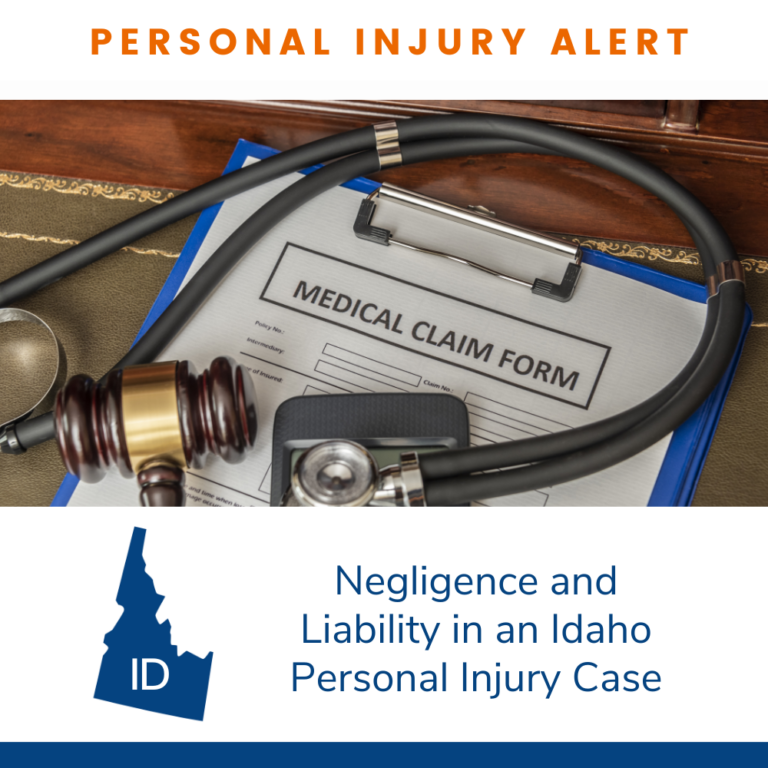
In Idaho, personal injury cases typically hinge on proving negligence and establishing liability. Understanding these concepts is essential for anyone involved in or pursuing a personal injury claim. Here’s an overview of how negligence and liability work in the context of Idaho law.
Negligence
Negligence is a legal theory that must be proven in most personal injury cases. To establish negligence in Idaho, the plaintiff must demonstrate the following elements:
- Duty of Care:
- The defendant owed a legal duty to the plaintiff. For example, drivers owe a duty to operate their vehicles safely and obey traffic laws.
- Breach of Duty:
- The defendant breached that duty by acting or failing to act in a certain way. This could include actions like speeding, running a red light, or failing to maintain a property.
- Causation:
- The breach of duty caused the plaintiff’s injuries. There are two types of causation:
- Actual Cause (Cause in Fact): The plaintiff must show that the injury would not have occurred but for the defendant’s actions.
- Proximate Cause: The plaintiff must prove that the injury was a foreseeable result of the defendant’s actions.
- The breach of duty caused the plaintiff’s injuries. There are two types of causation:
- Damages:
- The plaintiff suffered actual damages as a result of the breach. This can include medical expenses, lost wages, pain and suffering, and other losses.
Sources
- Idaho Code § 6-801 et seq.NOLO: Understanding Negligence
Liability
Liability in personal injury cases refers to the legal responsibility for the damages caused by negligence. In Idaho, several principles and laws govern liability:
- Comparative Negligence:
- Idaho follows a system of modified comparative negligence. Under Idaho Code § 6-801, the plaintiff’s compensation is reduced by their percentage of fault, unless the plaintiff was 50% or more at fault. In that case, they cannot recover any damages.
- When there are multiple defendants, Idaho applies the “individual rule.” This rule requires that each individual defendant’s negligence exceeds the plaintiff’s negligence for the plaintiff to obtain a judgment against that defendant. There is an exception to the individual rule when one defendant is vicariously liable for the acts of another defendant. In that case, a plaintiff may recover if the defendants’ negligence in the aggregate exceeds the plaintiff’s negligence.
- Example 1: The plaintiff is 20% at fault and the defendant is 80% at fault. If the damages amount to $100,000, then the plaintiff can recover $80,000.
- Example 2: The plaintiff is 41% at fault, the first defendant is 40% at fault, and the second defendant is 19% at fault. There is no vicarious liability. The plaintiff cannot recover from either defendant.
- Example 3: The plaintiff is 41% at fault, the first defendant is 40% at fault, and the second defendant is 19% at fault. The second defendant is vicariously liable for the negligence of the first defendant. The plaintiff can obtain a judgment against the second defendant for 59% of their damages. If the damages amount to $100,000, they can recover $59,000 from the second defendant.
- Joint and Several Liability:
- In cases involving multiple defendants, Idaho follows a rule of joint and several liability. Joint and several liability applies to defendants that “act[ed] in concert,” which means they pursued a common plan or one defendant was the agent of the other. In that case, each defendant can be held individually responsible for the entire amount of the plaintiff’s damages, regardless of their individual share of the fault.
- This principle ensures that the plaintiff can recover the full amount of damages even if one or more defendants cannot pay.
- Vicarious Liability:
- Employers can be held liable for the negligent actions of their employees if the actions occurred within the scope of employment. This is known as respondeat superior.
- Premises Liability:
- Landowners can be held liable if they keep their property in unsafe conditions, resulting in injury. Whether the landowner is at fault depends on if the plaintiff was an invitee (business patron), licensee (social guest), or trespasser.
Sources:
- FindLaw: Idaho Comparative Negligence
- Idaho Code §§ 6-801 to -806.
- Ross v. Coleman Co., 114 Idaho 817, 761 P.2d 1169 (1988).
- Adams v. Krueger, 124 Idaho 74, 856 P.2d 864 (1993).
Conclusion
In Idaho, establishing negligence and liability in a personal injury case requires demonstrating that the defendant breached a duty of care, causing the plaintiff’s injuries and resulting in damages. Understanding the principles of comparative negligence, joint and several liability, and other relevant laws is crucial for successfully navigating a personal injury claim.
For more detailed information, consulting with a personal injury attorney familiar with Idaho law can provide valuable guidance and ensure that your rights are protected throughout the legal process.
